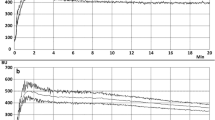Abstract
The impact of percentage of sourdough (SD) addition and presence of yeast (Y) and/or commercial wheat gluten (G) -added singly and in binary combination- on both small and large deformation rheological performance and viscometric profile of durum wheat bread doughs was considered. Eight distinctive rheological dough features were identified as able/capable to clearly differentiate soured bread doughs made with semolina:remilled semolina rate of 80:20 into defined functional quality groups. The presence of added commercial wheat gluten provided firmer, more elastic and more extensible doughs with slightly lower viscometric profile. Simultaneous presence of yeast/sourdough and yeast/gluten modulate single effects of sourdough on the durum wheat bread dough mechanical properties. Several relationships were found between fundamental and empirical rheological properties and within viscometric features of soured semolina doughs.



Similar content being viewed by others
References
Quaglia GB (1988) In: AACC International (ed) Other durum wheat products, in Durum: chemistry and technology. St Paul, MN, pp 263–282
Liu CY, Shepherd KW, Rathjen AJ (1996) Improvement of durum wheat pastamaking and breadmaking qualities. Cereal Chem 73:155–166
Corsetti A, Gobbetti M, Balestrieri M, Paoletti F, Russi L, Rossi J (1998) Sourdough lactic acid bacteria effects on bread firmness and staling. J Food Sci 63:347–351
Chiavaro E, Vittadini E, Musci M, Bianchi F, Curti E (2008) Shelf—life stability of artisanally and industrially produced durum wheat sourdough bread (‘‘Altamura bread’’). Z Lebensm Unters Forschsch 41:58–70
Sapirstein HD, David P, Preston KR, Dexter JE (2007) Durum wheat breadmaking quality: effects of gluten strength, protein composition, semolina particle size and fermentation time. J Cereal Sci 45:150–161
Dobraszczyk BJ, Morgenstern MP (2003) Rheology and the breadmaking process. J Cereal Sci 38:229–245
Collar C, Armero E (1996) Physico-chemical mechanisms of bread staling during storage: formulated doughs as a technological issue for improvement of bread functionality and keeping quality. Rec Res Dev Nutr Res 1:115–143
Collar C, Benedito de Barber C, Martínez-Anaya MA (1994) Microbial sourdoughs influence acidification properties and breadmaking potential of wheat dough. J Food Sci 59:629–633
Zotta T, Piraino P, Ricciardi A, Mc Sweeney PLH, Parente E (2006) Proteolysis in model sourdough fermentations. J Agric Food Chem 54:2567–2574
Thiele C, Grassi S, Ganzle M (2004) Gluten hydrolysis and depolimerisation during sourdough fermentation. J Agric Food Chem 52:1307–1314
Armero E, Collar C (1998) Crumb firming kinetics of wheat breads with anti-staling additives. J Cereal Sci 28:165–174
Collar C (2003) Significance of viscosity profile of pasted and gelled formulated wheat doughs on bread staling. Eur Food Res Technol 216:505–513
Armero E, Collar C (1997) Texture properties of formulated wheat doughs. Z Lebensm Unters Forschsch 204:136–145
Angioloni A, Balestra F, Pinnavaia GG, Dalla Rosa M (2008) Small and large deformation tests for the evaluation of frozen dough viscoelastic behaviour. J Food Eng 87:527–531
Angioloni A, Collar C (2009) Significance of structuring/prebiotic blends on bread dough thermo-mechanical profile. Eur Food Res Technol 229:603–610
Angioloni A, Collar C (2009) Gel, dough and fibre enriched fresh breads: relationships between quality features and staling kinetics. J Food Eng 91:526–532
ICC (2007) International Association for Cereal Science and Technology. Standard No. 104/1 approved 1960, revised 1990; No. 105/2 approved 1980, revised 1994; No. 107/1 approved 1968, revised 1995; No. 110/1 approved 1960, revised 1976; No. 115/1 approved 1972, revised 1992; No. 121 approved 1972, revised 1992; No. 136 approved 1984; No. 151 approved 1990; No. 158 approved 1994; No. 162 approved 1996. ICC, Vienna
Arbeitsgemeinschaft Getreideforschung e.V. (1994) Standard Methoden für Getreide Mehl und Brot, 7th edn. Verlag Moritz Schäfer, Detmold, Germany
Hoseney RC, Chen WZ (1994) US Patent 5 280 616
Collar C, Andreu P, Martínez JC, Armero E (1999) Optimization of hydrocolloid addition to improve wheat bread dough functionality: a response surface methodology study. Food Hydrocolloids 13(6):467–475
Smewing J (1995) The measurement of dough and gluten extensibility using the SMS/Kieffer rig and the TA.XT2 texture analyser. Stable Micro Systems Ltd, Surrey, UK
Edwards NM, Dexter JE, Scanlon MG (2001) The use of rheological techniques to elucidate durum wheat dough stretch properties. In: The fifth Italian conference on chemical and process engineering, Florence, Italy. vol 2 (pp 825–830)
Edwards NM, Mulvaney SJ, Scanlon MG, Dexter JE (2003) Role of gluten and its components in determining durum semolina dough viscoelastic properties. Cereal Chem 80:755–763
Edwards NM, Dexter JE, Scanlon MG (2002) Starch participation in durum dough linear viscoelastic properties. Cereal Chem 79:850–856
Khatkar BS, Schofield JD (2002) Dynamic rheology of wheat flour dough. I. Non-linear viscoelastic behaviour. J Sci Food Agric 82:827–829
Barber B, Ortola C, Barber S, Fernandez F (1992) Storage of packaged white bread. Effects of sour dough and addition of acids on bread characteristics. Z Lebensm Unters Forschsch 194:442–449
Thomas DJ, Atwell WA (1997) Grain-based product. In: AACC (ed) Starches. Eagan Press Handbook Series, MN, pp 65–74
Clarke CI, Schober TJ, Dockery P, O’Sullivan K, Arendt EK (2004) Wheat sourdough fermentation. Effect of time and acidification on fundamental rheological properties. Cereal Chem 81:409–417
Schober TJ, Dockery P, Arendt EK (2003) Model studies for wheat sourdough systems using gluten, lactate buffer and sodium chloride. Eur Food Res Technol 217:235–243
Acknowledgments
Authors greatly acknowledge the financial support of the Spanish Institution Ministerio de Ciencia e Innovación (Project AGL2008-00092) and of the Regione Autonoma della Sardegna (Project Master and Back). The authors thank Manuela Sanna for providing the inoculum for SD preparation.
Author information
Authors and Affiliations
Corresponding author
Rights and permissions
About this article
Cite this article
Fadda, C., Angioloni, A., Piga, A. et al. Impact of sourdough, yeast and gluten on small and large deformation rheological profiles of durum wheat bread doughs. Eur Food Res Technol 231, 431–440 (2010). https://doi.org/10.1007/s00217-010-1300-0
Received:
Revised:
Accepted:
Published:
Issue Date:
DOI: https://doi.org/10.1007/s00217-010-1300-0




